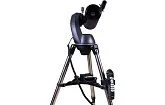Beginner’s Rövid útmutató teleszkópokhoz kezdőknek (angol nyelven)
- Category: Size
- Category: Magnification
- Category: Types
Reflector
Refractor - Category: Mount
Alt-Az mountr
Equatorial mount
Category: Size
It is a common misconception that telescopes are distinguished by their magnitude. The truth is that any telescope with the appropriate eyepiece can attain any level of magnification. Therefore, instead of magnitude, the size of the lens, or mirror, is used to categorize telescopes. The larger the size of the lens, the more objects you will be able to see, and the higher degree of magnitude you can achieve while still yielding a nice, sharp image. So, for example, a 10” telescope with a magnitude of 120x is better than a 3” telescope with the same magnitude.
Based on the size, telescopes are generally divided as follows:
- Small (4” or less);
- Medium (5”–8”);
- Large (10” and more).
Although larger telescopes do yield higher-resolution images, they are not necessarily the best choice because they are less portable and more expensive. You should consider all pros and cons before going for a larger telescope.
Category: Magnification
Yet another common misconception is that the greater the magnitude, the better the telescope. As the magnitude increases, the quality of the image decreases, especially in smaller telescopes. Although you can get even the 500x magnification on the smallest telescope (with a very poor image), you are not likely to need a magnitude higher than 350x at all. In fact, you will do perfectly fine with 200x, basically, for any purpose.
By the way, if you are still debating whether to go with a smaller telescope, keep in mind that the appropriate magnitude is calculated based on the size of the telescope. For each inch, you get an extra 30–50x magnification in good weather conditions. For example, your 2.4 inch telescope, given a clear sky, can have a magnitude of approximately 120x. With this magnitude, you can see the rings of Saturn or cloud belts on Jupiter.
As you might know, you can change the eyepiece on the telescope, thus changing the magnification. Magnification is calculated by dividing the focal length of the eyepiece into the focal length of the telescope. For instance, the magnification of a telescope of 1000 mm focal length with a lens of 25 mm focal length will equal 40x. This simple formula will help you when you decide to upgrade your telescope.
Category: Types
If you have ever had any interest in telescopes, you may have heard the words "reflector" and "refractor", and perhaps you had no idea what they meant. In simple terms, the reflector reflects light beams from one mirror to another within the telescope tube and into the eyepiece. These telescopes are less expensive to produce and therefore cost less. Yet they produce great magnification and images of high quality. A 4.5” reflector is just the right thing for a beginner, even if you have a modest budget.
The problem with the reflectors is that they are not very user friendly; the mirrors inside need adjustments, from time to time, and cleaning, because they gather dust. Also, they are not the best option for children because the eyepiece is located at the top of the tube.
A refractor refracts, or deflects, a light beam. It uses lenses instead of mirrors. The light travels into the tube through the lens at the top of the tube and into the eyepiece at the bottom. By the way, the symbol of a telescope that most people are familiar with—a nice, thin, slightly widening tube on a mount—is by appearance a typical refractor.
Refractors, as opposed to reflectors, are user friendly—very high quality images, solid design, virtually no maintenance needed, and the eyepiece is located at the bottom of the tube, which makes it accessible to children. However, they are the most expensive telescope you might find. The larger the telescope, the higher the price.
Of course, there are fusions of the two types that use both mirrors and lenses, but that is beyond the scope of this discussion.
Category: Mount
A telescope's mount is a very important piece. First of all, the tube has to stay steady for you to see a sharp image. Second, the tube has to move with the object observed so it doesn't disappear from your sight. Without a mount, this is impossible to achieve.
There are several types of telescope mounts:
Alt-Az mount. This is the basic type. The tube is positioned firmly and you can move it up, down, right, and left to keep up with your star. This type of mount is inexpensive and hard to break. At the same time, because this type is not so smooth, it is more difficult for beginners to follow the object with this mount.
- Fork mount. This is a type of Alt-Az mount, but with a little motor. It can be used without a tripod. You can place the telescope on a flat surface as you would a camera.
- GOTO mount. This is another type of Alt-Az mount, but with a computer that tells you where the object you are looking for is and when you've reached it. But after that, you are on your own.
- Motorized GOTO mount. It doesn't just find the object; it tracks it for you.
- GPS equipped motorized GOTO mount. This is the only type of mount that locates where you are so that you don't have to input your coordinates manually.
Equatorial mount. This mount is similar to the Alt-Az mount, the only difference being that to follow the object, all you need to do is nudge the tube (smooth movement is possible).
Tilos az anyag bármilyen jellegű másolatának közzététele bármely információs médiumban és bármilyen formában. Ez cikk a hu.levenhuk.com aktív hivatkozás feltüntetésével hivatkozható.
A gyártó fenntartja magának a jogot az árak, a termékkínálat és a műszaki paraméterek előzetes értesítés nélkül történő módosítására, vagy egyes termékek előzetes értesítés nélküli megszűntetésére.



